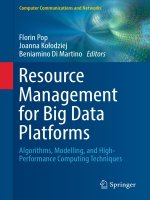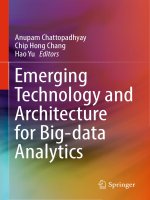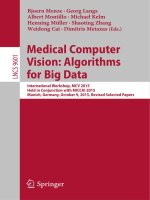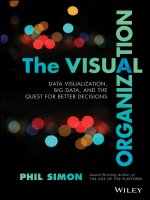Talend for big data
Bạn đang xem bản rút gọn của tài liệu. Xem và tải ngay bản đầy đủ của tài liệu tại đây (4.83 MB, 96 trang )
www.it-ebooks.info
Talend for Big Data
Access, transform, and integrate data using Talend's
open source, extensible tools
Bahaaldine Azarmi
BIRMINGHAM - MUMBAI
www.it-ebooks.info
Talend for Big Data
Copyright © 2014 Packt Publishing
All rights reserved. No part of this book may be reproduced, stored in a retrieval
system, or transmitted in any form or by any means, without the prior written
permission of the publisher, except in the case of brief quotations embedded in
critical articles or reviews.
Every effort has been made in the preparation of this book to ensure the accuracy
of the information presented. However, the information contained in this book is
sold without warranty, either express or implied. Neither the author, nor Packt
Publishing, and its dealers and distributors will be held liable for any damages
caused or alleged to be caused directly or indirectly by this book.
Packt Publishing has endeavored to provide trademark information about all of the
companies and products mentioned in this book by the appropriate use of capitals.
However, Packt Publishing cannot guarantee the accuracy of this information.
First published: February 2014
Production Reference: 2170214
Published by Packt Publishing Ltd.
Livery Place
35 Livery Street
Birmingham B3 2PB, UK.
ISBN 978-1-78216-949-9
www.packtpub.com
Cover Image by Abhishek Pandey ()
www.it-ebooks.info
Credits
Author
Project Coordinator
Bahaaldine Azarmi
Ankita Goenka
Reviewers
Proofreader
Simone Bianchi
Mario Cecere
Vikram Takkar
Indexers
Hemangini Bari
Acquisition Editors
Mary Nadar
Tejal Soni
Llewellyn Rozario
Production Coordinator
Content Development Editor
Komal Ramchandani
Manasi Pandire
Cover Work
Technical Editors
Komal Ramchandani
Krishnaveni Haridas
Anand Singh
Copy Editor
Alfida Paiva
www.it-ebooks.info
About the Author
Bahaaldine Azarmi is the cofounder of reach5.co. With his past experience of
working at Oracle and Talend, he has specialized in real-time architecture using
service-oriented architecture products, Big Data projects, and web technologies.
I like to thank my wife, Aurelia, for her support and patience
throughout this project.
www.it-ebooks.info
About the Reviewers
Simone Bianchi has a degree in Electronic Engineering from Italy, where he
is living today, working as a programmer to develop web applications using
technologies such as Java, JSP, jQuery, and Oracle. After having a brief experience
with the Oracle Warehouse Builder tool, and as soon as the Talend solution came out,
he started to extensively use this new tool in all his data migration/integration tasks
as well as develop ETL layers in data warehouse projects. He also developed several
Talend custom components such as tLogGrid, tDBFInput/Output, which you can
download from the TalendForge site, and the ones to access/store data on the Web
via SOAP/REST API.
I'd like to thank Packt Publishing to have chosen me to review
this book, as well as the very kind people who work there,
to have helped me to accomplish my first review at my best.
A special dedication to my father Americo, my mother Giuliana,
my sisters Barbara and Monica, for all their support over the years,
and finally to my little sweet nephew and niece, Leonardo and Elena,
you are my constant source of inspiration.
www.it-ebooks.info
Vikram Takkar is a freelance Business Intelligence and Data Integration
professional with nine years of rich hands-on experience in multiple BI and ETL
tools. He has a strong expertise in technologies such as Talend, Jaspersoft, Pentaho,
Big Data-MongoDB, Oracle, and MySQL. He has managed and successfully
executed multiple projects in data warehousing and data migration developed
for both Unix and Windows environments. He has also worked as a Talend Data
Integration trainer and facilitated training for various corporate clients in India,
Europe, and the United States. He is an impressive communicator with strong
leadership, analytical, and problem-solving skills. He is comfortable interacting
with people across hierarchical levels for ensuring smooth project execution as per
the client's specifications. Apart from this, he is a blogger and publishes articles and
videos on open source BI and ETL tools along with supporting technologies on his
YouTube channel at www.youtube.com/vtakkar. You can follow him on Twitter
@VikTakkar and you can visit his blog at www.vikramtakkar.com.
I would like to thank the Packt Publishing team for again giving
me the opportunity to review their book. Earlier, I reviewed their
Pentaho and Big Data Analytics book.
www.it-ebooks.info
www.PacktPub.com
Support files, eBooks, discount offers and more
You might want to visit www.PacktPub.com for support files and downloads
related to your book.
Did you know that Packt offers eBook versions of every book published, with PDF
and ePub files available? You can upgrade to the eBook version at www.PacktPub.
com and as a print book customer, you are entitled to a discount on the eBook copy.
Get in touch with us at for more details.
At www.PacktPub.com, you can also read a collection of free technical articles,
sign up for a range of free newsletters and receive exclusive discounts and offers
on Packt books and eBooks.
TM
Do you need instant solutions to your IT questions? PacktLib is Packt's online
digital book library. Here, you can access, read and search across Packt's entire
library of books.
Why Subscribe?
• Fully searchable across every book published by Packt
• Copy and paste, print and bookmark content
• On demand and accessible via web browser
Free Access for Packt account holders
If you have an account with Packt at www.PacktPub.com, you can use this to access
PacktLib today and view nine entirely free books. Simply use your login credentials
for immediate access.
www.it-ebooks.info
www.it-ebooks.info
Table of Contents
Preface1
Chapter 1: Getting Started with Talend Big Data
5
Talend Unified Platform presentation
5
Knowing about the Hadoop ecosystem
7
Prerequisites for running examples
8
Downloading Talend Open Studio for Big Data
9
Installing TOSBD
9
Running TOSBD for the first time
10
Summary12
Chapter 2: Building Our First Big Data Job
13
Chapter 3: Formatting Data
27
Chapter 4: Processing Tweets with Apache Hive
39
TOSBD – the development environment
13
A simple HDFS writer job
16
Checking the result in HDFS
25
Summary25
Twitter Sentiment Analysis
27
Writing the tweets in HDFS
28
Setting our Apache Hive tables
31
Formatting tweets with Apache Hive
35
Summary38
Extracting hashtags
39
Extracting emoticons
44
Joining the dots
46
Summary48
www.it-ebooks.info
Table of Contents
Chapter 5: Aggregate Data with Apache Pig
49
Chapter 6: Back to the SQL Database
59
Chapter 7: Big Data Architecture and Integration Patterns
65
Knowing about Pig
49
Extracting the top Twitter users
51
Extracting the top hashtags, emoticons, and sentiments
56
Summary58
Linking HDFS and RDBMS with Sqoop
59
Exporting and importing data to a MySQL database
60
Summary64
The streaming pattern
65
The partitioning pattern
68
Summary71
Appendix: Installing Your Hadoop Cluster with Cloudera CDH VM 73
Downloading Cloudera CDH VM
73
Launching the VM for the first time
75
Basic required configuration
76
Summary78
Index79
[ ii ]
www.it-ebooks.info
Preface
Data volume is growing fast. However, data integration tools are not scalable
enough to process such an amount of data, and thus, more and more companies
are thinking about starting Big Data projects—diving into the Hadoop ecosystem
projects, understanding each technology, learning MapReduce, Hive SQL,
and Pig-Latin—thereby becoming more of a burden more than a solution.
Software vendors such as Talend are trying to ease the deployment of Big Data
by democratizing the use of Apache Hadoop projects through a set of graphical
development components, which doesn't require the developer to be a Hadoop
expert to kick off their project.
This book will guide you through a couple of hands-on techniques to get a better
understanding of Talend Open Studio for Big Data.
What this book covers
Chapter 1, Getting Started with Talend Big Data, explains the structure of Talend
products and then sets up your Talend environment and discovers Talend Studio
for the first time.
Chapter 2, Building Our First Big Data Job, explains how we can start creating our first
HDFS job and be sure our Talend Studio is integrated with our Hadoop cluster.
Chapter 3, Formatting Data, describes the basics of Twitter Sentiment Analysis and
gives an introduction to format data with Apache Hive.
Chapter 4, Processing Tweets with Apache Hive, shows advanced features of Apache
Hive, which helps to create the sentiment from extracted tweets.
www.it-ebooks.info
Preface
Chapter 5, Aggregate Data with Apache Pig, finalizes the data processing done so
far and reveals the top records using Talend Big Data Pig components.
Chapter 6, Back to the SQL Database, will guide you on how to work with the Talend
Sqoop component in order to export data from HDFS to a SQL Database.
Chapter 7, Big Data Architecture and Integration Patterns, describes the most used
patterns deployed in the context of Big Data projects in an enterprise.
Appendix, Installing Your Hadoop Cluster with Cloudera CDH VM describes the main
steps to set up a Hadoop cluster based on Cloudera CDH4.3. You would learn how
to go about installations and configuration.
What you need for this book
You will need a copy of the latest version of Talend Open Studio for Big Data,
a copy of Cloudera CDH distribution, and a MySQL database.
Who this book is for
This book is for developers with an existing data integration background, who want
to start their first Big Data project. Having a minimum of Java knowledge is a plus,
while having an expertise in Hadoop is not required.
Conventions
In this book, you will find a number of styles of text that distinguish between
different kinds of information. Here are some examples of these styles, and an
explanation of their meaning.
Code words in text, database table names, folder names, filenames,
file extensions, pathnames, dummy URLs, user input, and Twitter handles are
shown as follows: The custom UDF is present in the org.talend.demo package
and called ExtractPattern
A block of code is set as follows:
CREATE EXTERNAL TABLE hash_tags (
hash_tags_id string,
day_of_week string,
[2]
www.it-ebooks.info
Preface
day_of_month string,
time string,
month string,
New terms and important words are shown in bold. Words that you see on the
screen, in menus or dialog boxes for example, appear in the text like this: So my
advice would be to create an account or click on Ignore if you already have one.
Warnings or important notes appear in a box like this.
Tips and tricks appear like this.
Reader feedback
Feedback from our readers is always welcome. Let us know what you think about
this book—what you liked or may have disliked. Reader feedback is important for
us to develop titles that you really get the most out of.
To send us general feedback, simply send an e-mail to ,
and mention the book title via the subject of your message.
If there is a topic that you have expertise in and you are interested in either writing
or contributing to a book, see our author guide on www.packtpub.com/authors.
Customer support
Now that you are the proud owner of a Packt book, we have a number of things
to help you to get the most from your purchase.
Downloading the color images of this book
We also provide you a PDF file that has color images of the screenshots/diagrams
used in this book. The color images will help you better understand the changes in
the output. You can download this file from />default/files/downloads/9499OS_Graphics.pdf
[3]
www.it-ebooks.info
Preface
Errata
Although we have taken every care to ensure the accuracy of our content, mistakes
do happen. If you find a mistake in one of our books—maybe a mistake in the text or
the code—we would be grateful if you would report this to us. By doing so, you can
save other readers from frustration and help us improve subsequent versions of this
book. If you find any errata, please report them by visiting ktpub.
com/submit-errata, selecting your book, clicking on the errata submission form link,
and entering the details of your errata. Once your errata are verified, your submission
will be accepted and the errata will be uploaded on our website, or added to any list of
existing errata, under the Errata section of that title. Any existing errata can be viewed
by selecting your title from />
Piracy
Piracy of copyright material on the Internet is an ongoing problem across all media.
At Packt, we take the protection of our copyright and licenses very seriously. If you
come across any illegal copies of our works, in any form, on the Internet, please
provide us with the location address or website name immediately so that we
can pursue a remedy.
Please contact us at with a link to the suspected
pirated material.
We appreciate your help in protecting our authors, and our ability to bring
you valuable content.
Questions
You can contact us at if you are having a problem
with any aspect of the book, and we will do our best to address it.
[4]
www.it-ebooks.info
Getting Started with
Talend Big Data
In this chapter, we will learn how the Talend products are regrouped as an
integration platform, and we'll set up our development environment to start
building Big Data jobs.
The following topics are covered:
• Talend Unified Platform structure
• Setting up our Talend development environment
Talend Unified Platform presentation
Talend is a French software vendor specialized in open source integration.
Through its products, the company democratizes integration and enables IT
users and organizations to deploy complex architectures in simpler and
comprehensive ways.
www.it-ebooks.info
Getting Started with Talend Big Data
Talend addresses all aspects of integration from the technical layer to the business
layer, and all products are regrouped into one unique unified platform as shown
in the following diagram:
Talend Unified Platform
Talend Unified Platform offers a unique Eclipse-based environment, which means
that users can jump from one product to another just by clicking on the related
perspective button without the need for changing tools. All jobs, services, and
technical assets are designed in the same environment with the same methodology,
deployed and executed in the same runtime, monitored and operated in the same
management console.
• Talend Data Integration is the historical Talend product, which rapidly
promoted Talend as a leader in its field. It allows developers to create the
simplest integration jobs such as extracting data from a file and loading it
to a database, and create complex data integration job orchestration, high
volume integration with parallelization feature, and finally Big Data
Integration mainly based on Hadoop projects. This book is essentially
dedicated to this module and will give the reader a better understanding
of the Talend Big Data usage module.
• Talend Data quality comes with additional analytics features mainly
focused on data profiling in order to get a better understanding not only
of the quality and reliability of your data, but also integration features such
as data standardization, enrichment, matching, and survivorship based on
largely adopted industry algorithms.
• Talend Enterprise Service Bus is mainly based on open source projects
from the Apache Software Foundation such as Apache Karaf, Apache
CXF, Apache Camel, and Apache ActiveMQ, all packed into a single
comprehensive product, which speeds the deployment of Service
Oriented Architecture composed of few services, to large and
complex distributed instance architectures.
[6]
www.it-ebooks.info
Chapter 1
• Talend Master Data Management manages the best of all products and
offers business customers all the features required to manage master
data such as a business user interface, workflow and business processes,
data quality controls, and role-based access management.
• Talend Business Process Management will help business users to
graphically design their business processes composed of human tasks,
events, and business activity monitoring. It also takes advantage of all
existing integration services such ESB SOAP and REST Services or even
Data Quality jobs, thanks to a comprehensive integration layer between
all products.
Talend Unified Platform is part of the commercial subscription offer; however,
all products are available under a community version called Talend Open Studio.
As mentioned earlier, Talend Unified Platform is unified at every level, whereas
Talend community version products are separate studios. It doesn't include
teamwork module, and also advanced features such as administration console,
clustering, and so on globally.
This book is focused on Talend Open Studio for Big Data (TOSBD), which adds
to Talend Open Studio for Data Integration a set of components that enables
developers to graphically design Hadoop jobs.
Knowing about the Hadoop ecosystem
To introduce the Hadoop projects ecosystem, I'd like to use the following diagram
from the Hadooper's group on Facebook ( />which gives a big picture of the positioning of the most used Hadoop projects:
[7]
www.it-ebooks.info
Getting Started with Talend Big Data
As you can see, there is a project for each task that you need to accomplish in a
Hadoop cluster which is explained in the following points:
• HDFS is the main layer where the data is stored. We will see in the
following chapter how to use TOSBD to read and write data in it.
More information can be found at />docs/stable1/hdfs_design.html.
• MapReduce is a framework used to process a large amount of data stored
in HDFS, and it relies on a map function that processes key values pairs
and a reduce function to merge all the values as the following publication
explains />• In this book, we will use a bunch of high-level projects over HDFS, such as
Pig and HIVE, in order to generate the MapReduce code and manipulate
the data in an easier way instead of coding the MapReduce itself.
• Other projects such as Flume or Sqoop are used for integration purpose
with an industry framework and tools such as RDBMS in the case of Sqoop.
The more you get into Big Data projects, the more skills you need, the more time you
need to ramp up on the different projects and framework. TOSBD will help to reduce
this ramp up time by providing a comprehensive graphical set of tools that ease the
pain of starting and developing such projects.
Prerequisites for running examples
As described earlier in this chapter, this book will describe how to implement Big Data
Hadoop jobs using TOSBD. For this the following technical assets will be needed:
• A Windows/Linux/Mac OS machine
• Oracle (Sun) Java JDK 7 is required to install and run TOSBD, and is available
at />jdk7-downloads-1880260.html
• Cloudera CDH Quick Start VM, a Hadoop distribution, which by default
contains a ready-to-use single node Apache Hadoop is available at
/>download-components/download-products.html?productID=F6mO278Rvo
• A VMWare Player or VirtualBox free for personal use (for windows and
linux only) to run the Cloudera VM available at />en/web/vmware/free#desktop_end_user_computing/vmware_player/
6_0 and />
[8]
www.it-ebooks.info
Chapter 1
• MySQL Database, an open source RDBMS, is available at
/>
• And obviously, TOSBD, which is described in the next part
Downloading Talend Open Studio for
Big Data
Downloading a community version of Talend is pretty straightforward; just connect
on and scroll at the bottom of the
page to see the download section as shown in the following screenshot:
Talend Open Studio for Big Data download section
The product is a generic bundle, which can be run either on Mac, Linux, or Windows.
This book uses the last version of the product; just click on the Download now button
to get the TOS_BD-r110020-V5.4.0.zip archive of TOSBD.
Installing TOSBD
All products of the Talend community version are of Eclipse-based tooling
environment and packaged as archive. To install TOSBD, you only need to extract
the archive preferably under a path, which doesn't contain any space, for example:
Operating system
Path
Mac, Linux
/home/username/talend/
Windows
C:\talend\
The result should be a directory called TOS_BD-r110020-V5.4.0 under the
example path.
[9]
www.it-ebooks.info
Getting Started with Talend Big Data
Running TOSBD for the first time
As said earlier in the download section of this chapter, the product is generic and
is packaged in one archive for several environments; thus, running TOSBD is just
a matter of choosing the right executable file in the installation directory.
All executable filenames have the same syntax:
TOS_BD-[Operating system]-[Architecture]-[Extension]
Then, to run TOS_BD on a 64-bit Windows machine, TOS_BD-win-x86_64.exe
should be run, TOS_BD-macosx-cocoa for Mac, and so on. Just choose the one
that fits your configuration.
The first time you run the studio, a window will pop up asking to accept the terms
of use and license agreement; once accepted, the project configuration wizard will
appear. It presents the existing project, in our case, only the default demo project
exists. The wizard also proposes to import or create a project.
When you work with Talend products, all your developments are
regrouped in a project, which is then stored in a workspace with
other projects.
We are now going to create the project, which will contain all development done
in this book. In the project wizard, perform the following steps:
• Click on the Create button to open the project details window as shown in
the following screenshot:
Project details window
[ 10 ]
www.it-ebooks.info
Chapter 1
• Name your project; I've set the name to Packt_Big_Data; you don't really
need the underscores, but you might guess that's just a habit of mine.
• Click on Finish; you are now ready to run the studio:
TOSBD project configuration done
• A window will appear to let you create a Talend Forge account, which
is really useful if you want to get the latest information on the products,
interact with the products community, get access to the forum and also
to the bug tracker (Jira), and more. So my advice would be to create an
account or click on Ignore if you already have one.
• The studio will load all Big Data edition components and then open
the welcome window, scroll down in the window, and check the Do
not display again checkbox for the next studio boot as shown in the
following screenshot:
Studio welcome page
• You are now ready to start developing your first Talend Big Data job!
[ 11 ]
www.it-ebooks.info
Getting Started with Talend Big Data
Summary
So far, we have learned the difference between Talend Unified Platform and
Talend Community Edition, and also how fast it is to set up a Talend Open
Studio for Big Data development environment.
In the next chapter, we'll learn how to build our first job and discover a couple
of best practices and all the main features of TOSBD.
[ 12 ]
www.it-ebooks.info
Building Our First Big
Data Job
This chapter will help you to understand how the development studio is organized
and then how to use TOSBD components to build Big Data jobs.
In this chapter, we will cover the following:
• TOSBD – the development environment
• Configuring the Hadoop HDFS connection
• Writing a simple job that writes data in Hadoop HDFS
• Running the job
• Checking the result in HDFS
TOSBD – the development environment
We are ready to start developing our Big Data jobs, but before diving into serious
things, be my guest and have a nickel tour of the studio.
www.it-ebooks.info
Building Our First Big Data Job
The studio is divided into the following parts:
• The Repository view on the left contains all the technical artifacts designed
in the studio, such as jobs, context variables, code, and connection resources,
as shown in the following screenshot:
The TOSBD Studio's Repository view
• In the center, there is a design view in which the graphical implementation
takes place, and various components are arranged to create a job according
to the business logic. Here, the developer just drags and drops components
from the Palette view to the design view and connects them to create a
job, as shown in the following screenshot (remember that Talend is a code
generator, so anything contained in the design view is actually a piece of the
generated code. The design view contains a code; you can switch from the
design view to read the generated code):
[ 14 ]
www.it-ebooks.info









